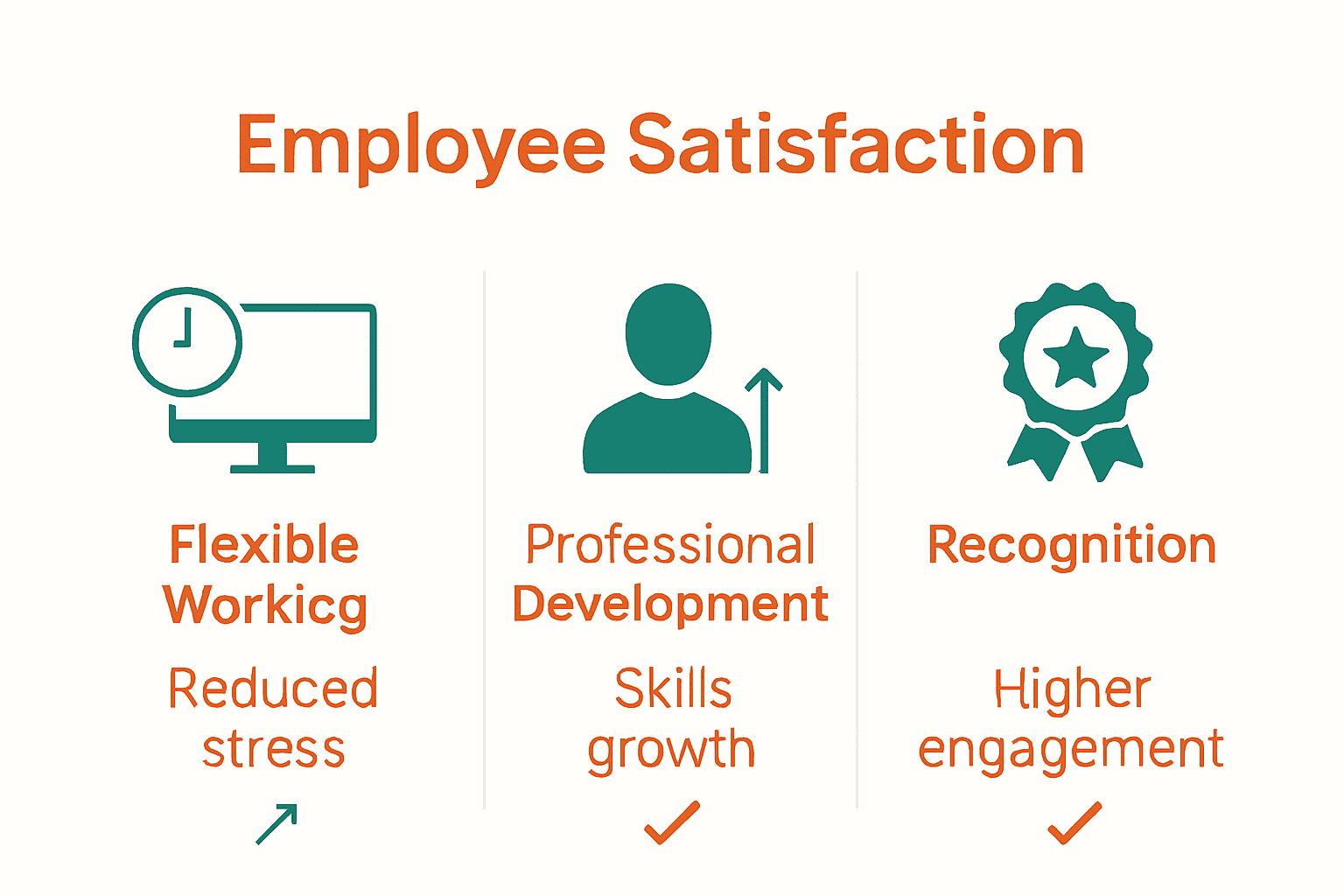Did you know that organisations with high employee satisfaction can experience up to 20 percent higher productivity? Workers who feel valued and fulfilled are not just happier but also drive better business results. Understanding what truly shapes contentment at work is no longer optional for employers who want lasting success. By recognising what motivates today’s employees, businesses can foster loyalty, boost morale, and create healthier workplaces for everyone.
Key Takeaways
| Point | Details |
|---|---|
| Employee Satisfaction Impact | Employee satisfaction enhances organizational performance, driving productivity and financial outcomes. |
| Holistic Satisfaction Strategies | Effective strategies must address psychological needs, professional autonomy, and workplace culture beyond monetary compensation. |
| Importance of Workplace Environment | A well-maintained physical workspace significantly influences staff contentment and morale. |
| Measuring Satisfaction Effectively | Organizations should employ nuanced metrics like employee engagement and retention to assess satisfaction without over-reliance on financial incentives. |
Table of Contents
- Defining Employee Satisfaction And Its Importance
- Types Of Employee Satisfaction Strategies
- Key Factors Influencing Staff Contentment
- Implementing Effective Satisfaction Programs
- Measuring Success And Avoiding Pitfalls
Defining Employee Satisfaction And Its Importance
Employee satisfaction represents the emotional and psychological connection workers feel towards their workplace, encompassing their overall sense of wellbeing, engagement, and fulfilment in their professional roles. More than just a paycheck, it reflects how valued, supported, and motivated employees feel within their organisational environment.
According to research from the UK’s Chartered Institute of Personnel and Development, employee satisfaction significantly impacts organisational performance. Their findings reveal that happier workers are substantially more productive, making more sales and contributing more positively to financial outcomes. Critically, the research suggests that improving job satisfaction through strategic interventions like providing autonomy, constructive feedback, and manager training proves far more effective than sporadic wellness programmes.
Key drivers of employee satisfaction extend well beyond monetary compensation. A survey of UK health and social care workers highlighted that employees prioritise psychological factors such as:
- Sense of purpose in their work
- Feeling of belonging within their team
- Job security
- Professional independence
- Workplace flexibility
These insights demonstrate that modern employees seek meaningful workplace experiences that align with their personal values and professional aspirations. 8 Essential Employee Wellbeing Ideas for Every Workplace can provide further strategies for creating a supportive and engaging work environment that nurtures employee satisfaction and organisational success.
Types Of Employee Satisfaction Strategies
Employee satisfaction strategies are targeted approaches organisations implement to enhance workplace engagement, motivation, and overall employee experience. These strategies go beyond traditional compensation models, focusing on holistic workplace improvements that address psychological, professional, and personal needs.
A groundbreaking UK trial involving 61 companies and 2,900 employees demonstrated the power of innovative workplace models. The four-day workweek experiment revealed significant benefits, including:
- Reduced employee stress and burnout
- Increased job satisfaction
- Stable or higher company revenue
- Lower employee turnover rates
Another compelling research study on hybrid working models highlighted transformative workplace strategies. The research found that employees working partly from home experienced remarkable improvements:
- Less workplace burnout
- Better sleep and overall health
- Improved work-life balance
- Enhanced productivity and motivation
- Reduced resignation rates, particularly among women and those with long commutes
Modern employee satisfaction strategies encompass various approaches, including flexible working arrangements, professional development opportunities, mental health support, recognition programmes, and creating inclusive workplace cultures. These multifaceted strategies recognize that employees seek meaningful work experiences that align with their personal and professional aspirations.
IMAGE:descriptive_key_1] [8 Essential Employee Wellbeing Ideas for Every Workplace provides additional insights into developing comprehensive employee satisfaction initiatives.
Here’s a comparison of common employee satisfaction strategies and their key impacts:

| Strategy Type | Approach Examples | Main Impacts |
|---|---|---|
| Flexible Working | Four-day week Hybrid models |
Reduced stress Improved work-life balance Higher retention |
| Professional Development | Training programmes Personalised career paths |
Skills growth Greater motivation Internal promotions |
| Recognition & Feedback | Regular reviews Awards programmes |
Higher engagement Sense of value |
| Wellbeing & Mental Health Support | Counselling Wellbeing initiatives |
Less burnout Improved morale |
| Inclusive Workplace Culture | Diversity policies Team-building |
Stronger belonging Enhanced productivity |
Key Factors Influencing Staff Contentment
Workplace environment plays a crucial role in determining employee satisfaction, extending far beyond simple monetary compensation. Understanding the complex interplay of physical, psychological, and professional factors is essential for organisations seeking to create genuinely supportive and engaging workspaces.
A comprehensive UK study revealed startling insights into workplace design and its impact on staff contentment. Remarkably, fifty-one percent of employees cited poor workplace maintenance as a significant source of dissatisfaction. The research highlighted that workplace infrastructure directly influences employee morale, with 89% of workers who feel satisfied with their physical work environment also reporting high satisfaction with their employer.
Key factors influencing staff contentment include:
- Physical workplace quality and maintenance
- Safety and comfort of working environment
- Professional development opportunities
- Workplace autonomy and decision-making power
- Quality of interpersonal relationships
- Alignment between personal values and organisational culture
A systematic review of NHS literature further emphasised that while financial compensation matters, it is insufficient as a standalone strategy for staff retention and satisfaction.
VIDEO:video_content] The research underscored that intrinsic motivators such as professional autonomy, quality of care, morale, and personal growth significantly impact employee contentment. These findings suggest that organisations must adopt holistic approaches that address both tangible and intangible aspects of the work experience. [8 Essential Employee Wellbeing Ideas for Every Workplace offers additional strategies for creating a supportive and engaging workplace environment.
Implementing Effective Satisfaction Programs
Employee satisfaction programs represent strategic initiatives designed to create a holistic, supportive workplace environment that goes beyond traditional human resources approaches. These comprehensive programs aim to address both professional and personal needs of employees, fostering a culture of engagement, growth, and mutual respect.
The Investors in People standard provides a robust framework for organisations seeking to implement effective satisfaction strategies. This UK-based accreditation emphasises structured support, professional development, and engagement methods that directly contribute to improved employee performance and workplace contentment.
Key components of successful satisfaction programs include:
- Structured professional development pathways
- Regular, constructive performance feedback
- Line manager training and leadership development
- Enhanced workplace autonomy
- Personalised career progression opportunities
- Mental health and wellbeing support
UK experts recommend moving away from sporadic wellness initiatives towards embedding satisfaction strategies into daily work practices. This approach focuses on creating systemic changes that genuinely impact employee experience. Critical strategies include:
- Empowering employees with greater decision-making authority
- Providing consistent, meaningful feedback
- Investing in line manager training to improve team dynamics
- Creating transparent communication channels
- Developing personalised professional growth plans
These research-backed approaches demonstrate that effective satisfaction programs are not one-size-fits-all solutions but nuanced, tailored interventions that recognize the unique needs of each workforce. 8 Essential Employee Wellbeing Ideas for Every Workplace offers additional insights into developing comprehensive employee engagement strategies.
Measuring Success And Avoiding Pitfalls
Employee satisfaction measurement requires a sophisticated, multifaceted approach that goes beyond simplistic metrics and generic wellness initiatives. Successful organisations understand that tracking employee contentment demands nuanced strategies tailored to specific workplace contexts and individual team dynamics.
Research from the NHS systematic review highlights critical measurement approaches, emphasising the importance of tracking outcomes like staff retention, morale, and productivity. The study warns against relying solely on financial incentives, recommending instead data-driven, bespoke strategies that address unique organisational needs.
Key metrics for measuring employee satisfaction include:
- Staff retention rates
- Employee engagement scores
- Productivity levels
- Internal promotion opportunities
- Absenteeism and turnover rates
- Quality of inter-team communication
- Employee feedback and survey results
Common pitfalls organisations must avoid include:
- Implementing generic wellness programmes
- Focusing exclusively on financial compensation
- Neglecting individual team differences
- Failing to provide meaningful professional development
- Overlooking psychological aspects of workplace satisfaction
UK research warns that many wellness programmes primarily engage already healthy employees, suggesting a more strategic approach. Organisations should prioritise improving workplace autonomy, enhancing feedback mechanisms, and developing manager capabilities to create meaningful satisfaction strategies. 8 Essential Employee Wellbeing Ideas for Every Workplace provides additional insights into developing comprehensive measurement approaches that genuinely reflect employee experiences.
Turn Workplace Satisfaction Into Real Results With Custom Floor Solutions
Every business leader knows that employee satisfaction goes beyond pay and benefits. This article shows how a safe, supportive environment and strong organisational culture are crucial drivers for staff wellbeing, engagement and retention. Many teams struggle with issues like poor physical workplace quality, maintenance concerns and a lack of belonging. These problems can quietly undermine morale and even lead to higher staff turnover.

At Mats4U, we help you address these critical concerns, making it simple to create a welcoming, hygienic and professional workspace. Enhance team satisfaction quickly by choosing from our made-to-measure custom mats and floor coverings, including anti-slip, logo, and industry-specific options. Demonstrate your commitment to workplace wellbeing and create a first impression that truly fits your company’s values. Act now to give your workplace an upgrade that supports happier, more productive employees. Visit Mats4U today to discover solutions tailored for your unique environment.
Frequently Asked Questions
What is employee satisfaction?
Employee satisfaction is the emotional and psychological connection that workers feel towards their workplace, reflecting their overall wellbeing, engagement, and fulfilment in their professional roles.
Why is employee satisfaction important for organizations?
Employee satisfaction directly impacts organizational performance, with happier employees being more productive and contributing positively to financial outcomes. It is crucial for retention and reducing turnover rates.
What are some effective strategies to enhance employee satisfaction?
Effective strategies include offering flexible working arrangements, providing professional development opportunities, implementing recognition programs, and fostering an inclusive workplace culture.
How can organizations measure employee satisfaction?
Organizations can measure employee satisfaction through key metrics such as staff retention rates, employee engagement scores, productivity levels, turnover rates, absenteeism, and feedback from employee surveys.









